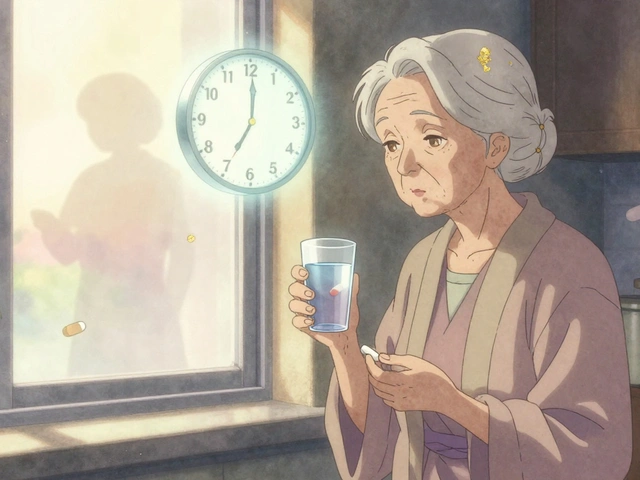
Many people take duloxetine to manage depression, anxiety, or chronic pain. But if you’ve been told to watch your blood pressure while on this medication, you’re not alone. It’s a real concern - and one that’s often misunderstood. Duloxetine doesn’t raise blood pressure in everyone, but for some, it can. And knowing whether you’re at risk could prevent a serious health issue.
How Duloxetine Affects Blood Pressure
Duloxetine, sold under the brand name Cymbalta, works by increasing serotonin and norepinephrine in the brain. These are neurotransmitters that help regulate mood. But norepinephrine also acts on the body’s nervous system - including the blood vessels. When levels go up, blood vessels can tighten, which pushes blood pressure higher.
This isn’t a myth or a rare side effect. In clinical trials, about 5% of people taking duloxetine saw their systolic blood pressure rise by 10 mm Hg or more. For some, it was even higher. The risk is greater if you’re already on other medications that affect blood pressure, or if you have untreated hypertension.
It’s not just about the dose. Even at standard levels - 30 mg or 60 mg daily - blood pressure changes can happen. And they don’t always show up right away. Some people notice a spike after a few weeks, others after months. That’s why regular monitoring matters more than you might think.
Who’s Most at Risk?
Not everyone taking duloxetine will see their blood pressure climb. But certain groups are more likely to:
- People with existing high blood pressure (even if it’s controlled)
- Those over 65 years old
- Patients taking other stimulants or decongestants (like pseudoephedrine)
- People with thyroid disorders or heart disease
- Those on MAO inhibitors or other antidepressants that affect norepinephrine
Even if you’ve never had high blood pressure before, you could develop it while on duloxetine. That’s why your doctor should check your blood pressure before you start - and again after 2 to 4 weeks.
What to Do If Your Blood Pressure Rises
If your readings go above 140/90 mm Hg while taking duloxetine, don’t panic. But don’t ignore it either. Here’s what to do:
- Check your blood pressure at home twice a day for a week. Use a validated device - not a wrist monitor.
- Write down the readings, including the time and whether you were stressed, active, or resting.
- Call your doctor. Don’t wait for your next appointment.
- Do not stop duloxetine suddenly. Stopping cold turkey can cause withdrawal symptoms like dizziness, nausea, or brain zaps.
Your doctor may adjust your dose, switch you to a different medication, or add a blood pressure pill. Many patients successfully manage both conditions. One 2023 study in the Journal of Clinical Psychiatry found that 72% of patients who needed a blood pressure medication while on duloxetine were able to stay on both without issues.

What You Can Do at Home
Medication isn’t the only factor. Lifestyle choices can either help or hurt your blood pressure while on duloxetine.
- Reduce salt intake. Even 1,500 mg less per day can lower systolic pressure by 5 to 8 mm Hg.
- Avoid alcohol. It can spike blood pressure and worsen side effects like dizziness.
- Exercise regularly. Walking 30 minutes a day helps your heart and can offset medication-induced pressure rises.
- Manage stress. Anxiety raises blood pressure - and duloxetine is often prescribed for anxiety. But if your anxiety isn’t under control, your pressure might still climb.
- Don’t use OTC cold meds with decongestants. Pseudoephedrine and phenylephrine can dangerously raise blood pressure when mixed with duloxetine.
Some patients think they can skip blood pressure checks because they feel fine. But high blood pressure doesn’t come with warning signs. That’s why it’s called the silent killer. You might feel perfectly normal - even better - while your pressure climbs.
Alternatives to Duloxetine
If your blood pressure stays high despite lifestyle changes and monitoring, your doctor might consider switching you to another medication. Here are common alternatives:
| Medication | Blood Pressure Risk | Common Use |
|---|---|---|
| Duloxetine | Moderate to high | Depression, anxiety, nerve pain |
| Escitalopram (Lexapro) | Low | Depression, anxiety |
| Sertraline (Zoloft) | Low | Depression, OCD, PTSD |
| Mirtazapine (Remeron) | Low to none | Depression, insomnia |
| Venlafaxine (Effexor) | High (similar to duloxetine) | Depression, anxiety |
Escitalopram and sertraline are often preferred when blood pressure is a concern. They work on serotonin alone, not norepinephrine, so they’re less likely to raise pressure. Mirtazapine can be a good option if sleep issues are also a problem.
But switching isn’t always simple. If duloxetine is working well for your pain or mood, your doctor may try adding a blood pressure medication instead - like an ACE inhibitor or calcium channel blocker. These often work well with duloxetine and don’t interfere with its antidepressant effects.

When to Seek Emergency Help
Most blood pressure increases on duloxetine are mild and manageable. But if you experience any of these, get help right away:
- Systolic pressure above 180 mm Hg or diastolic above 120 mm Hg
- Severe headache, blurred vision, or chest pain
- Sudden confusion, trouble speaking, or weakness on one side of the body
- Shortness of breath or irregular heartbeat
These could signal a hypertensive crisis or stroke. Don’t wait. Call emergency services or go to the nearest hospital.
Monitoring Your Blood Pressure Like a Pro
Here’s how to track your pressure effectively:
- Use an upper-arm cuff monitor - not a wrist or finger device.
- Take readings in the morning before medication and in the evening.
- Sit quietly for 5 minutes before measuring. No talking, no phone use.
- Keep both feet flat, back supported, arm at heart level.
- Record each reading in a notebook or app - include date, time, and symptoms.
- Bring your log to every doctor visit.
Many patients forget to track this. But when they do, they catch problems early. One patient in Auckland, 58, noticed her pressure had climbed from 125/80 to 150/95 over six weeks. She brought her log to her GP. They lowered her duloxetine dose and added a low-dose amlodipine. Within a month, her pressure was back to normal.
Final Thoughts
Duloxetine is a powerful tool for many people. But like all medications, it comes with trade-offs. High blood pressure is one of them - and it’s one you can manage if you’re aware. The key is not fear, but vigilance.
Don’t assume you’re fine because you feel better emotionally. Your body might be sending a different signal. Regular checks, honest conversations with your doctor, and smart lifestyle choices make all the difference.
If you’re on duloxetine and haven’t checked your blood pressure in the last 3 months, schedule it now. It could be the most important appointment you make this year.
Does duloxetine always raise blood pressure?
No. Only about 5% of people taking duloxetine experience a significant rise in blood pressure. Most people have no change at all. But because the risk exists, everyone should have their blood pressure checked before starting and again after a few weeks.
Can I stop duloxetine if my blood pressure goes up?
Never stop duloxetine suddenly. Doing so can cause withdrawal symptoms like dizziness, nausea, irritability, or electric shock sensations. If your blood pressure rises, talk to your doctor. They can adjust your dose, add a blood pressure medication, or switch you to another antidepressant safely.
Is it safe to take duloxetine with blood pressure pills?
Yes, many people take both safely. Common blood pressure medications like amlodipine, lisinopril, or metoprolol don’t interfere with duloxetine. Your doctor will choose one that works with your overall health. Always tell your doctor about all medications you’re taking - including over-the-counter ones.
How long does it take for duloxetine to affect blood pressure?
Changes can happen anytime - from the first week to several months later. That’s why doctors recommend checking blood pressure after 2 to 4 weeks of starting the medication, then again at 3 months. Even if you feel fine, don’t skip these checks.
What’s the best alternative to duloxetine if I have high blood pressure?
Escitalopram (Lexapro) and sertraline (Zoloft) are often the best choices because they don’t affect norepinephrine, so they’re less likely to raise blood pressure. Mirtazapine is another option, especially if you struggle with sleep. But the right choice depends on your symptoms, other health conditions, and how well you responded to past treatments.





Neil Mason
October 29, 2025 AT 10:30Been on duloxetine for 8 months for back pain and my BP crept up slowly. Didn't notice till my wife made me check it at home. Turned out it was 152/94. I started walking daily and cut the salt like they said. Got it down to 128/82 with a tiny dose of amlodipine. Don't panic, just track it. This post saved me.
Andrea Gracis
October 30, 2025 AT 00:32i had no idea duloxetine could do this. i thought it was just for mood. my doc never mentioned bp. i feel kinda stupid for not asking. but now im gonna start checking mine twice a week. thanks for the heads up
Matthew Wilson Thorne
October 31, 2025 AT 05:095% is statistically significant. The real issue is that clinicians treat this as a footnote, not a clinical consideration.
April Liu
November 1, 2025 AT 13:32Hey, I'm so glad you shared this! 🙌 I was on duloxetine for anxiety and my BP jumped too - I thought I was just stressed. Turns out it was the med. I switched to sertraline and my numbers are back to normal. You're not alone. And yes, DO NOT stop cold turkey - I learned that the hard way 😅
Emily Gibson
November 2, 2025 AT 13:02This is so important. I'm a nurse and I've seen too many patients ignore their BP because they 'feel fine.' But high blood pressure doesn't care how you feel. It just keeps climbing. Please, if you're on this med, get that monitor. Even a cheap one from Walmart is better than nothing. Your future self will thank you.
Mirian Ramirez
November 4, 2025 AT 06:34Okay so I just want to say that I've been on duloxetine for like 2 years and my bp has been totally fine but I also do yoga and eat like a whole food plant based diet and I only drink green tea and I never use decongestants and I sleep 8 hours and I meditate daily so maybe that's why it didn't affect me? But I know people who took it and had crazy spikes and they were eating pizza and drinking wine and not moving at all so it's not just the med it's the lifestyle too. Also I think people should get their bp checked before they even start taking it like the article says but my doctor didn't and I had to ask for it myself and it was like 140/90 so we lowered my dose and added a tiny bit of lisinopril and now I'm golden. Just saying, don't assume it's fine just because you feel good emotionally. Your body is always talking, you just gotta listen.
Kika Armata
November 6, 2025 AT 06:27How is it even possible that this isn't front-and-center on every prescribing label? The fact that physicians routinely overlook this is a systemic failure. Anyone who takes duloxetine without baseline and follow-up BP monitoring is essentially gambling with their cerebrovascular health. And don't get me started on OTC decongestants - those are literally time bombs when combined with SNRIs. This is basic pharmacology. If your doctor doesn't know this, find a new one.
Herbert Lui
November 6, 2025 AT 12:42It's funny how we treat our minds like sacred temples but our bodies like disposable machines. Duloxetine lifts your soul but tightens your arteries - two sides of the same coin. We chase relief, but forget that every gain has a cost. Maybe the real question isn't whether the drug raises BP - but why we're so okay with trading one kind of suffering for another.
Nick Zararis
November 7, 2025 AT 16:56Important note: Always use an upper-arm cuff. Wrist monitors are unreliable. Always sit still for five minutes. Always record your readings. Always share them with your doctor. Always avoid pseudoephedrine. Always check your BP after 2–4 weeks. Always monitor consistently. Always be proactive. Always. Always. Always.
Sara Mörtsell
November 9, 2025 AT 07:59People act like this is some big secret but it's not. It's in the FDA label. It's in the prescribing info. It's been studied for over a decade. If you didn't know this, you didn't read the damn leaflet. Stop acting surprised. Knowledge is free. You just have to look.
Rhonda Gentz
November 9, 2025 AT 21:11There’s something quiet about high blood pressure. It doesn’t shout. It doesn’t cry. It just… grows. And by the time you notice, it’s already changed things. Duloxetine is one of those quiet thieves - it helps your mind, but it steals from your heart. I’m glad someone’s talking about it.
Alexa Ara
November 10, 2025 AT 19:06You got this! 🌱 I know it feels overwhelming, but tracking your BP is one of the most powerful things you can do for yourself. Even if it’s just once a week, you’re taking control. And if you need help finding a good monitor or logging app, I’ve got a list of my favorites - DM me! You’re not alone in this.